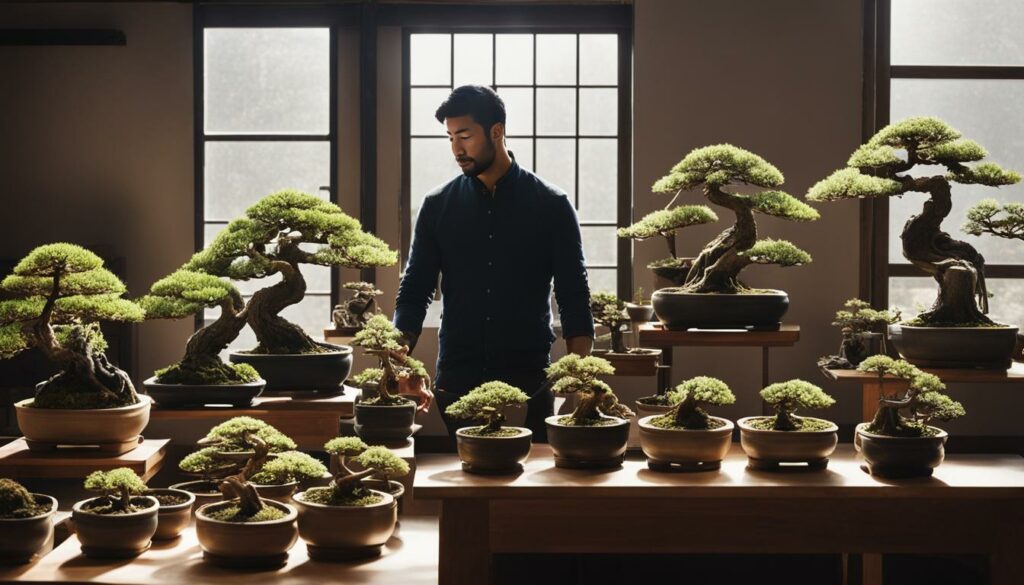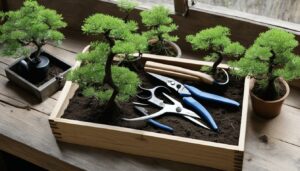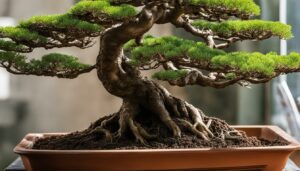Embarking on the intricate journey of choosing bonsai pots is a vital step in cultivating the timeless art form of your miniature tree. The quest for the ultimate bonsai aesthetics transcends mere visual appeal; it’s about creating an environment where your bonsai can thrive and please the eye. Diving into the world of bonsai containers, you’ll discover how each selection can tell its own story, complementing the delicate dance of branches and leaves that you’ve so carefully nurtured.
Key Takeaways
- Consider the harmony between the pot’s style and your bonsai’s form for a visually appealing display.
- Choose a pot that ensures the health of your bonsai through proper drainage and space for root development.
- The material of the bonsai pot impacts both the tree’s growth and the aesthetic presence it commands.
- Understand how pot size influences bonsai proportions and contributes to the overall balance.
- Remember the importance of pot durability and function, especially for bonsai living outside.
- Integrate the pot into your indoor decor for continuity and style within your living space.
- Ensure your selection of bonsai containers enriches the tree’s beauty and promotes a healthy ecosystem.
Understanding Bonsai Pot Essentials
As you nurture your bonsai, it’s essential to recognize that the pot you choose is more than a mere vessel; it’s a fundamental component of your tree’s well-being. The right pot size, material, and design are critical elements that contribute to the bonsai health and aesthetics.
The Role of Containers in Bonsai Health
Bonsai containers are integral to maintaining a healthy miniature tree. They must provide ample room for root development and ensure adequate drainage. Equally crucial is the pot’s role in influencing the temperature around the root system; a phenomenon vital in climates with extreme seasonal variations.
The synergy between pot size and tree size cannot be overstressed. A pot too small can restrict growth, while one too large can lead to waterlogging and root rot. The choice of bonsai containers, therefore, hinges on a delicate balance: facilitating growth while maintaining the overall miniature aesthetic.
Materials Commonly Used in Bonsai Pots
When selecting the perfect home for your bonsai, consider the variety of materials at your disposal. Each comes with its unique properties:
- Clay pots: Breathable and natural, enhancing root health and stability.
- Ceramic pots: Beautifully glazed, offering a wide spectrum of colors and pot designs, harmonizing with your bonsai’s presentation.
- Plastic pots: Lightweight and practical, although less aesthetically pleasing, reserved mainly for training or developing the bonsai.
Ultimately, your bonsai’s longevity and beauty are tied to the interplay of these considerations. By mindfully selecting a pot that accommodates the tree’s size, respects its health needs, and harmonizes with its design, you create an environment in which your bonsai can thrive and enchant.
The Art of Matching Your Bonsai with the Right Pot
Mastering the art of bonsai involves more than just shaping the tree—it’s about creating a harmonious aesthetic that appeals to the senses. The union of tree shape and pot design is critical in exhibiting the true essence of bonsai aesthetics. This synergy guides the eye, presenting a balanced and complete work of living art. Below, we explore how to pair your bonsai with the ideal pot.
Analyzing Tree Shape and Pot Design
Every bonsai has a distinct character, informed by its shape and structure. Identify whether your bonsai presents an upright, slanting, or cascading form. An upright bonsai may suit a simple, sturdy pot to contrast with its vertical dominance, whereas a slanting tree may require a wider container to support its angled growth. Cascading bonsai demand deeper pots, allowing their drooping branches to flow gracefully. The right pot design not only complements your bonsai’s morphology but enhances stability and growth.
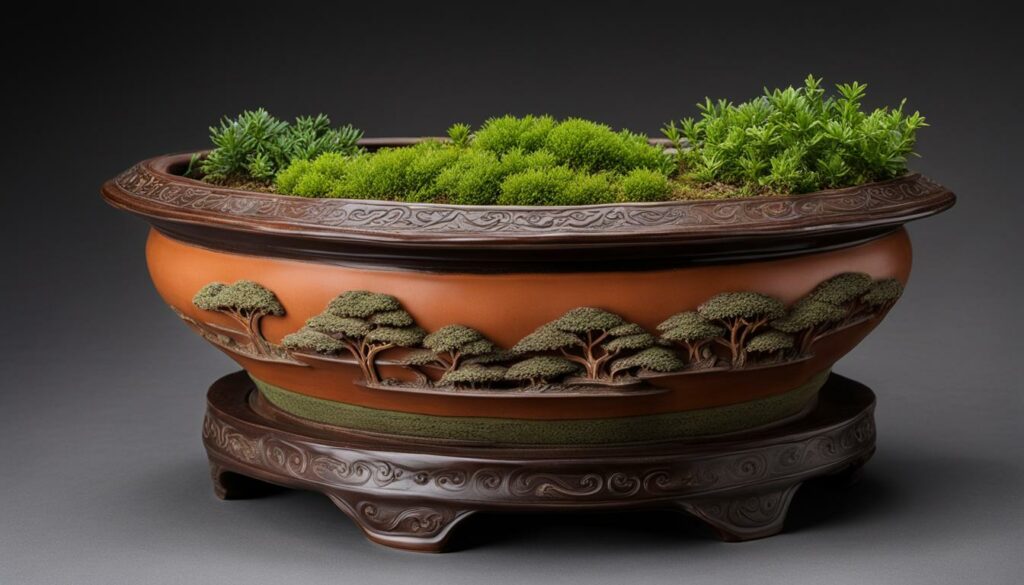
Color Coordination Techniques
Color plays a substantial role in the impact of your bonsai presentation. Coordination between the hues of your bonsai’s foliage, bark, and pot can elevate the overall aesthetic. Consider the seasonal changes of your bonsai—bright glazes may accentuate the vibrancy of autumnal leaves, while subdued tones can mirror the calmness of green, summer foliage. A basic guide is to match warm-colored pots with trees exhibiting warm-colored leaves or bark and to select cool-colored pots for bonsai with cooler hues in their palette.
- Warm-toned trees: Choose pots in earthy reds, yellows, or beiges.
- Cool-toned trees: Opt for pots in blues, greens, or greys.
In addition to color, texture can spark visual interest; does your tree have rough, textured bark or smooth foliage? Each detail can guide the selection of a pot with contrasting or complementary texture, playing into the depth of color coordination and tactile experience.
Through careful consideration of tree shape, pot design, and color, your bonsai will not merely live within a container—it will tell a story, evoke emotion, and resonate with the authenticity of its natural beauty.
Size Matters: Finding the Right Pot Dimensions
Choosing the optimal pot size for your bonsai is not a decision to be taken lightly. Whether you’re a seasoned bonsai cultivator or a beginner, understanding that both the health and the aesthetics of your bonsai are tied to its container is crucial. When choosing bonsai pots, it is essential to consider not only how the container will showcase your bonsai but also how it will affect its future growth and well-being.
To help you navigate the myriad of bonsai containers available, follow these guidelines designed to assist you in finding the right pot dimensions for your tree:
- Measure the Trunk: The width of the pot should typically be two-thirds the height of the bonsai from the soil level to the top of the tree. This provides a balanced aesthetic and ensures that the pot can accommodate root growth.
- Consider Tree Type: The type of bonsai you are potting impacts the choice of container. For instance, conifers may require deeper pots for extensive root systems, while deciduous trees can be suited to shallower containers.
- Account for Growth: Allow space for growth when selecting a pot. It should be neither too cramped nor excessively spacious to maintain proper scale and anticipate future growth spurts.
Below is a table to guide you through the general standards for pot size, relative to tree size:
| Tree Height | Pot Width | Pot Depth |
|---|---|---|
| 6″ (15cm) | 4″ (10cm) | 2″ (5cm) |
| 8″ (20cm) | 5.3″ (13.5cm) | 2.6″ (6.5cm) |
| 12″ (30cm) | 8″ (20cm) | 4″ (10cm) |
| 16″ (40cm) | 10.6″ (27cm) | 5.3″ (13.5cm) |
| 24″ (60cm) | 16″ (40cm) | 8″ (20cm) |
Selecting the right bonsai containers involves balancing the tree’s current stature and its future development. By applying these considerations and factoring in the tree’s unique characteristics, you ensure your bonsai has a suitable home that facilitates health and showcases its beauty effectively. Remember, every tree is an individual, and as such, selecting its container requires a personalized approach.
Practical Considerations for Outdoor Bonsais
When selecting a bonsai container for outdoor display, it’s essential to consider elements that contribute to both the survival and the aesthetic value of your tree. The ideal outdoor bonsai container must strike a balance between functionality and design to endure the changing seasons and elemental challenges.
Weather Resistance and Durability Factors
For outdoor bonsai enthusiasts, it’s crucial to choose pots with high weather resistance. Materials such as high-fired ceramics, concrete, or frost-resistant glazed pots are preferred due to their robustness. These pot durability factors not only extend the life of the bonsai containers but also ensure that the tree within is protected from extreme environmental conditions.
Drainage and Airflow Necessities
Sound drainage is not simply a feature; it is a fundamental necessity for the health of any outdoor bonsai. Robust drainage prevents waterlogged roots, which can be fatal in freezing conditions. Alongside effective drainage, sufficient airflow through the pot is vital. This combination ensures a healthy root system capable of sustaining the bonsai’s growth over the years.
| Material Type | Weather Resistance | Durability | Drainage and Airflow |
|---|---|---|---|
| High-fired Ceramic | Excellent | Long-lasting | Superior |
| Concrete | Very Good | Heavy, Durable | Good, if properly designed |
| Frost-resistant Glaze | Excellent | Varies with Thickness | Superior |
| Wood | Moderate | Varies with treatment | Good with adequate holes |
Selecting the right pot is a blend of art and science. As an outdoor bonsai curator, ensure your chosen bonsai containers not only stand up to the rigors of your climate but also harmonize with the unique spirit and character of your bonsai.
Indoor Bonsai Pot Selection
Bringing the serene beauty of nature into your home is a delightful experience with indoor bonsai. However, to truly captivate the essence of bonsai artistry, selecting the appropriate pot for your indoor setting is paramount. Not only does the pot play a crucial role in the health of your bonsai, but it also serves as a pivotal element in your interior decor. Let’s dive into the nuances of choosing bonsai containers that harmonize with your indoor environment while maintaining the well-being of these living sculptures.
Matching Pot Style with Interior Decor
When it comes to indoor bonsai, the pot style can make a significant statement in your home decor. Bonsai containers should align with the aesthetic of your living space, reflecting the themes and colors of your interior design. Selecting a pot that complements your room’s decor, furniture style, and color palette can truly unify your space and showcase your bonsai as a focal point.
Consider pot style and color: a minimalist space may benefit from clean lines and neutral tones, whereas a more eclectic room could afford bolder shapes and vibrant hues. Here are a few pot styles and how they might blend with various interior designs:
| Interior Design Style | Recommended Pot Style | Color Palette |
|---|---|---|
| Modern/Contemporary | Sleek geometric | Monochromatic, metallic accents |
| Traditional | Classic ceramic with ornate details | Earthy tones, deep blues, and greens |
| Bohemian | Rustic or handcrafted pots | Rich patterns, warm, vibrant colors |
| Scandinavian | Simple and functional with smooth finishes | Whites, grays, light woods |
| Industrial | Metallic or concrete pots | Neutral colors with a pop of green |
Caring for Bonsai in Indoor Environments
Once you have chosen a pot that enhances your home’s beauty, caring for your indoor bonsai becomes the next priority. Indoor conditions can significantly differ from the outdoors, with variations in light, humidity, and temperature—all factors that influence your bonsai’s health.
- Ensure proper drainage to prevent root rot, which could be detrimental in an indoor setting.
- Consider the placement of your bonsai; proximity to windows can affect light exposure, so rotate the plant periodically for uniform growth.
- Using a humidity tray and misting your bonsai can help maintain moisture levels, especially in dry interior climates.
To flourish inside, your bonsai requires thoughtful attention to these environmental elements. By marrying the aesthetics of pot style with the care that indoor bonsai necessitates, you can foster a healthy miniaturized tree that enhances your interior decor. Embrace the art of bonsai and invite the tranquility of nature into your home with the perfect fusion of form and function.
Choosing Bonsai Pots Based on Tree Species
When it comes to choosing bonsai pots, the distinction between tree species greatly impacts your selection. Each species presents unique requirements, and understanding these can help you harmonize bonsai aesthetics with your tree’s natural characteristics. In this section, we’ll cover how the notion of pot size, material, and style should be approached differently across various species.
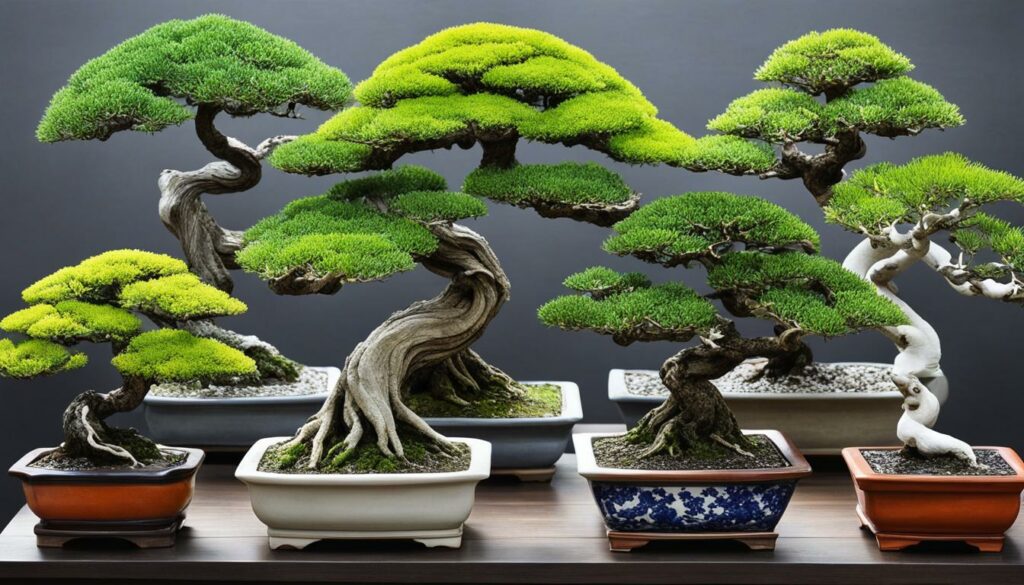
Conifer bonsai trees, for instance, tend to evoke a sense of longevity and strength, and as such, pairs well with pots that are understated and sturdy. Conversely, flowering bonsai trees demand pots that complement their vibrant blooms and delicate structures, often featuring softer lines and brighter colors. Deciduous trees, with their seasonal changes, call for a balanced approach that accommodates aesthetic shifts throughout the year.
| Tree Species | Recommended Pot Material | Suggested Pot Size | Style Notes |
|---|---|---|---|
| Conifer | Earthenware or Unglazed Ceramic | Shallow relative to trunk girth | Robust with natural, earthy tones |
| Flowering | Glazed Ceramic | Medium depth for root comfort | Curves that echo the tree’s blossoms |
| Deciduous | Wood or Glazed Pottery | Varies with tree’s canopy size | Versatile style for seasonal changes |
Remember, while aesthetics play a significant role in choosing bonsai pots, the pot’s functional requirements such as drainage, proper root development space, and compatibility with the tree’s growth must not be overlooked. It’s all about finding a cohesive balance that honors both the tree and the timeless art of bonsai.
The Importance of Pot Symmetry and Balance
When selecting the perfect pot for your bonsai, understanding the delicate interplay between pot symmetry and the visual weight of your tree is crucial. This equilibrium is not just pleasing to the eye but vital to the presentation of your bonsai, affecting its overall bonsai aesthetics. Whether you lean towards a symmetrical pot for a sense of harmony or an asymmetrical one to create interest, your choice will set the tone for your bonsai display.
Understanding Visual Weight in Pot Selection
Selecting a pot for your bonsai involves more than picking an attractive design; it’s about understanding the concept of visual weight. This refers to the perception of weight a pot appears to have based on its shape, size, and color, which can influence the stability and stature of your bonsai. A pot with the right visual weight enhances the natural beauty of your tree without overpowering it.
How Symmetry Influences Bonsai Aesthetics
Pot symmetry has a profound impact on the aesthetics of bonsai. A symmetrical pot, traditionally used for formal bonsai styles, can reflect a sense of order and tranquility. Asymmetric pots, on the other hand, may be better suited for more dynamic or naturalistic bonsai forms. While symmetry can provide balance, a carefully chosen asymmetrical pot might also balance a bonsai’s composition by contrasting the tree’s shape or directing visual flow.
As you ponder over the intricate dance of shapes and forms, remember that the pot design is not merely a container but a crucial component that completes the visual storytelling of your bonsai. Your intuition paired with these insights will guide you to find a harmonious vessel that both enhances the beauty of your bonsai and resonates with its spirit.
Customizing Pots for Bonsai Hobbyists
When you venture beyond simply choosing bonsai pots, customizing creates a personal connection between you and your bonsai. Embarking on a DIY project or working with skilled local pot crafters can lead to inspiring results, imbuing your bonsai display with character and charm unique to your personal vision.
DIY Bonsai Pot Ideas
The allure of a DIY bonsai pot lies in its potential for creativity and individual expression. With a few tools, some patience, and your imagination, you can transform standard containers into one-of-a-kind homes for your bonsai. Here are some ideas to get you started:
- Carving designs onto pre-made clay pots.
- Using mosaic techniques to add color and texture.
- Adapting and repurposing vintage containers that resonate with your personal style.
- Applying different glazing methods to create unique finishes.
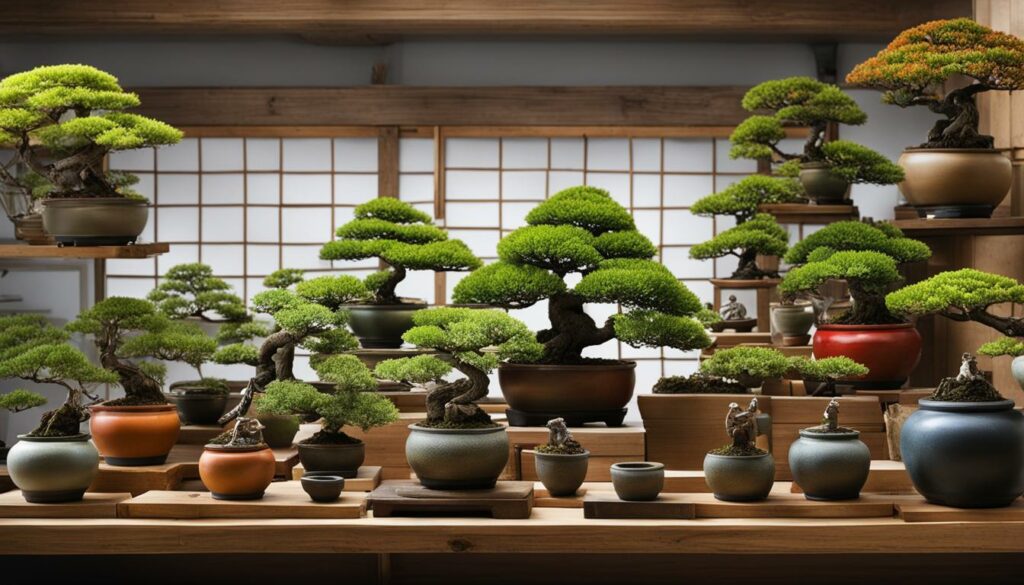
Working with Local Pot Crafters
Collaboration with local pot crafters can yield extraordinary and refined results. These artisans bring their expertise in materials and design to realize your vision for the perfect bonsai container:
- Discuss your bonsai’s needs and your aesthetic preferences with the crafter.
- Select a suitable material and design that complements both the tree and your space.
- Work closely through the process to ensure the final product is both functional and a true work of art.
By personalizing your bonsai’s home, you not only enhance its beauty but also forge a deeper bond with the art of bonsai cultivation itself.
Innovative Pot Styles: Exploring Modern Designs
As a bonsai enthusiast, your passion for these living sculptures is apparent in the care you dedicate to their cultivation. But beyond the meticulous trimming and watering lies another creative realm: the selection of bonsai pots. Today, innovative pot styles and modern designs are pushing the boundaries and offering fresh ways to express bonsai aesthetics. It’s no longer just about the tree; the pot itself has become a canvas for artistic expression.
Contemporary designers are reimagining traditional forms, introducing sleek lines, unexpected textures, and bold colors that challenge the classic paradigm. These modern designs do more than hold your precious bonsai; they interact with it, enhancing its beauty and reflecting your unique style.
| Feature | Traditional Pots | Modern Pots |
|---|---|---|
| Shape | Classic oval, rectangular shapes | Geometric, abstract forms |
| Texture | Smooth, often glazed | Varied, including raw, unglazed surfaces |
| Color | Earthen, muted tones | Vivid, striking hues |
| Material | Ceramic, clay | Resins, metals, mixed media |
| Aesthetic | Complementary, understated | Contrasting, statement-making |
As you reflect on these options, consider how a bold, minimalist pot might frame your bonsai, or how a vibrant color could bring out the best in your tree’s foliage. Whether you’re drawn to the austere beauty of a brutalist pot or the sleek charm of a glossy, futuristic vessel, these modern designs invite you to merge tradition with innovation. Embrace the progressive trends of innovative pot styles to truly let your bonsai aesthetics flourish in the modern age.
The Impact of Cultural Traditions on Bonsai Pot Shapes
Delving into the world of bonsai, one cannot help but be captivated by the harmony between the miniature trees and their containers. The pot, far from being a mere vessel, carries deep cultural significance and embodies the philosophies of the region from which it originates. In this exploration, we examine how longstanding cultural traditions have shaped the pot designs integral to bonsai presentation.
Japanese Versus Chinese Pot Influence
The serene beauty of Japanese bonsai pots reflects the country’s minimalist ethos, favoring simplicity and natural aesthetics. Rooted in a tradition that values subtlety, these pots often feature understated colors and clean lines that do not overshadow the tree itself. In contrast, Chinese pot influence is evident in more ornate and robust designs, sometimes featuring colorful glazes and intricate carved patterns, reflecting an embrace of more expressive artistic sensibilities.
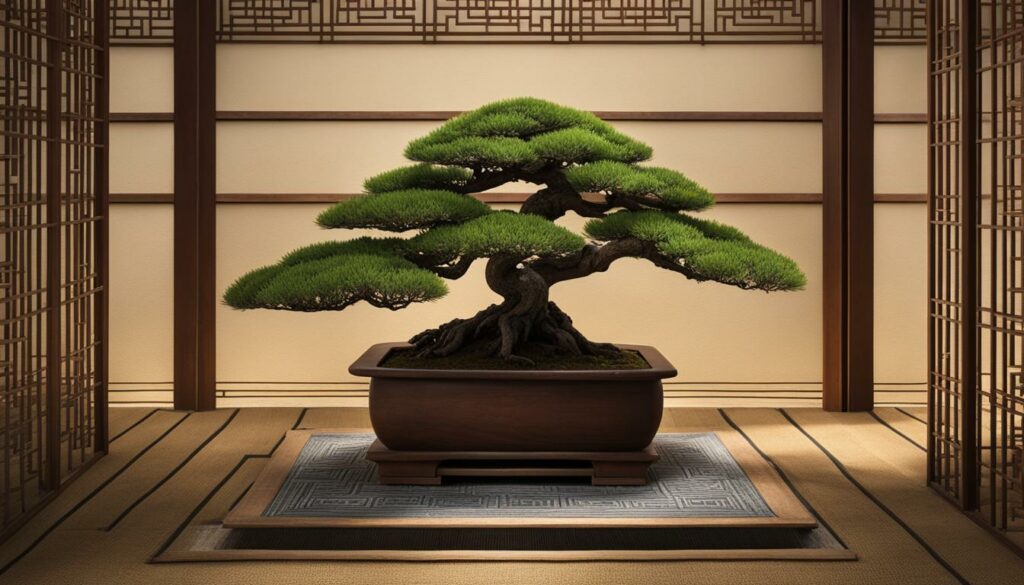
The Evolution of Contemporary Bonsai Containers
Modern bonsai artisans blend historical influences with new-age creativity, leading to the development of contemporary bonsai containers. These new designs often push the boundaries of tradition, incorporating unconventional shapes, textures, and even material innovations that marry cultural heritage with modern design principles.
| Characteristic | Japanese Bonsai Pots | Chinese Bonsai Pots | Contemporary Bonsai Containers |
|---|---|---|---|
| Color Palette | Neutral, earthy tones | Bright, varied hues | Broad spectrum including metallic finishes |
| Shapes | Symmetric, balanced forms | Often round or oval with bold contours | Geometric to free-form |
| Surface Design | Smooth, occasionally textured | Elaborate carvings or glaze details | Experimental textures and 3D printing |
| Cultural Significance | Reflects Zen principles and nature | Exudes historical artistry and folklore | Synthesis of traditional motifs with contemporary art |
As you venture into the world of bonsai, consider how each pot carries a story—a reflection of the rich tapestry of cultural traditions that continue to evolve. Whether favoring a classic Japanese style or an avant-garde contemporary creation, the choice of container is a pivotal decision in the artful journey of bonsai cultivation. Embrace the legacy behind these elegant vessels, for they are as much a part of bonsai’s soul as the living tree it cradles.
Ensuring Proper Pot Functionality for Bonsai Cultivation
As an aficionado of bonsai cultivation, you must recognize that the journey of nurturing these miniature marvels extends far beyond mere aesthetics. A crucial factor to this process is pot functionality. Indeed, the container in which your bonsai takes root plays an integral role in its development and vitality. Here, we delve into the essence of repotting, unpacking the best practices and spotlighting the indicators that suggest it’s time for a pot upgrade.
Repotting Best Practices
Repotting is a pivotal event in your bonsai’s life cycle. It’s not simply about changing its residence; it is about revitalizing its growth substrate and ensuring its health for the years to come. When you embark on this task, consider the timing—typically spring, when trees are bursting with vigor. It’s essential to choose the right soil mix, one that grants optimal drainage yet retains adequate moisture. Additionally, cautious root trimming is a crucial step, executed with precision to promote robust new growth while ensuring the tree’s stability.
Recognizing Signs that a Pot Upgrade is Needed
How do you discern when it’s time to consider a pot upgrade for your bonsai? There are several telltale signs that serve as a clarion call for immediate action. If you notice roots spiraling around the pot’s base, water draining sluggishly, or the tree toppling due to disproportionate top growth, it’s clear your bonsai is clamoring for additional space to thrive.
| Signs Your Bonsai Needs a New Pot | Reasons for Concern | Action Steps |
|---|---|---|
| Roots protruding from drainage holes | Inhibited growth and compromised health | Plan for repotting in appropriate season |
| Soil compacted and waterlogged | Poor air circulation and potential root rot | Refresh soil mixture; ensure it’s well-aerated |
| Slowed growth during growing season | Insufficient nutrients and space | Repot with a nutrient-rich soil mix |
In summary, whether you’re a seasoned bonsai cultivator or a hopeful green thumb, embrace these guiding pillars of pot functionality – the keystones of bonsai cultivation excellence. When it’s time to perform a painstaking repotting or to select a stately new vessel for your beloved bonsai, proceed with the knowledge that these efforts directly transplant into the flourishing and grandeur of your miniature arboreal artwork.
The Artistic Fusion of Bonsai Trees and Ceramic Mastery
As you delve into the world of bonsai trees, you’ll find that the ceramic mastery involved in creating their pots is nothing short of an artistic fusion. Both crafts share a deep respect for balance and detail, where the flourishing growth of bonsai is cradled by the hands of skilled potters. Each pot is more than a vessel; it is a piece of art that bestows upon the bonsai its unique sense of identity, grounding the ethereal nature of the tree with the earthiness of the container.
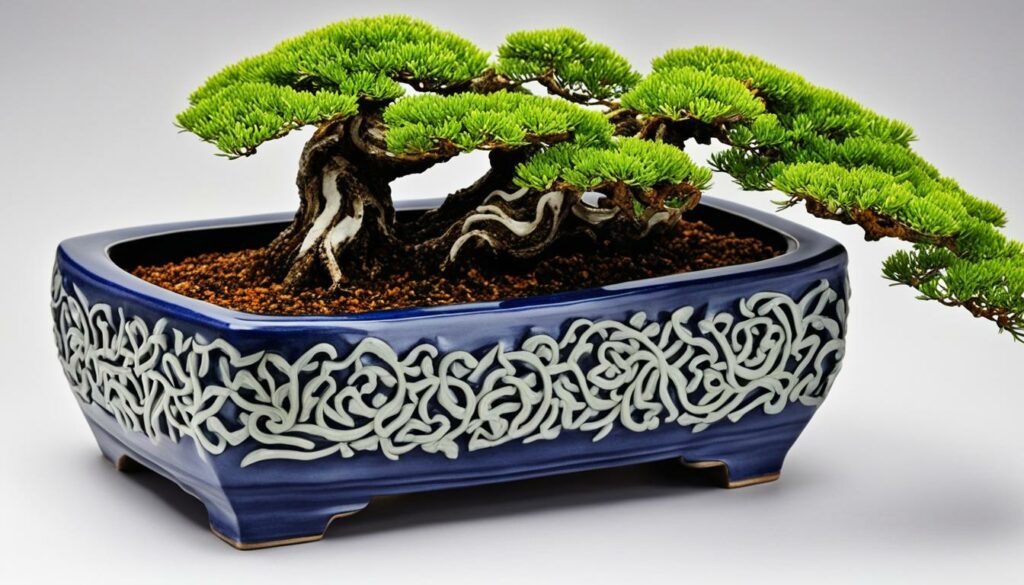
Master ceramists understand the subtle dance between form and function to ensure that each pot not only complements the artistic vision of the bonsai but also sustains the health and growth of these tiny giants. The meticulous attention to detail in ceramic design mirrors the careful pruning and shaping that bonsai trees undergo—each discipline enhancing the other in a mutual celebration of art and nature.
| Bonsai Style | Recommended Pot Shape | Pot Material Character |
|---|---|---|
| Upright (Chokkan) | Rectangular with sharp edges | Structured stability, enhancing vertical emphasis |
| Slanting (Shakan) | Deeper oval or round | Dynamic movement, showcasing angular growth |
| Cascading (Kengai) | Tall, deep pots | Vertical depth to complement the cascading elements |
Every bonsai enthusiast must eventually grapple with the decision of pairing their tree with the right pot—this is where the legacy of ceramic mastery comes to the forefront. The combined knowledge of centuries-old potting traditions with modern aesthetics results in pots that do more than house the bonsai; they honor each tree’s history and potential.
As your fingers trace the ridges and grooves of a bonsai pot, remember that it stands as a testament to the harmonious collaboration between the meticulous care of bonsai trees and the imaginative flair of pottery. The result of this artistic fusion is a comprehensive expression of beauty that transcends time, bridging the gap between ancient tradition and contemporary design.
Conclusion
As we encapsulate the insights from our exploration of bonsai pot selection, it is evident that the choices you make can have a profound impact on the aesthetic appeal and the health of your bonsai. The art of choosing bonsai pots is nuanced, embracing factors such as size, material, design, and balance, all working in concert to both showcase and nurture your miniature tree wonder. Each decision regarding the selection process reflects your dedication to cultivating bonsai, recognizing that the right container does more than just house your plant—it complements its essence.
Summarizing the Keys to Bonsai Pot Selection
Throughout our discussion, we emphasized the importance of harmony between the pot and the tree, considering aspects like pot size, material, and drainage capabilities. Remember that beyond aesthetics, functionality is paramount in promoting the health and growth of your bonsai. Weather resistance for outdoor pots, and interior design synchrony for indoor settings, serve to enhance the overall longevity and vibrancy of your bonsai.
Next Steps: Cultivating Your Bonsai Journey
With the foundations of bonsai pot selection firmly in mind, you are now equipped to elevate your bonsai practice. Whether you are refining your current collection or embarking on a new bonsai project, let your creativity and knowledge guide you. Embrace the journey of nurturing these living sculptures, and as you do, continue to enrich your understanding and appreciation for this ancient art form. The path of cultivating bonsai is one of patience, attention to detail, and an unwavering commitment to growth—not only of your trees but of your skills as a bonsai artisan.
FAQ
How do I select the perfect pot for my bonsai?
Selecting the perfect pot for your bonsai involves considering both aesthetics and functionality. Aesthetically, the pot should complement the tree’s shape, color, and style, contributing to the harmony and balance of the display. Functionally, the pot must have the correct size, drainage, and material to support your bonsai’s health and growth.
What role do bonsai containers play in tree health?
Bonsai containers play a crucial role in the health of your tree. They provide space for root growth, facilitate proper drainage, regulate moisture and temperature, and influence the tree’s overall stability. Choosing the right container is essential for ensuring your bonsai thrives.
What materials are commonly used in bonsai pots and why?
Common materials used for bonsai pots include clay, ceramic, and plastic. Clay and ceramic are favored for their breathability, drainage properties, and aesthetic appeal, while plastic might be chosen for its light weight and durability. Each material has its own impact on the bonsai’s moisture retention and temperature control.
How should I match my bonsai tree with the right pot design?
To match your bonsai with the right pot design, analyze the tree’s shape—upright, slanting, or cascading—and select a pot that accentuates these features. Consider the color and texture of the tree’s foliage and bark and choose a pot color that complements or contrasts these elements in a harmonious way.
Why does pot size matter for bonsai trees?
Pot size is critical for both the visual balance and health of your bonsai. The pot should be proportional to the tree, not too large to overshadow it, or too small to inhibit its growth. The right pot size supports adequate root growth and balances the visual weight of the tree.
What should I look for in a bonsai pot for outdoor environments?
For outdoor bonsai, look for pots that are durable and can withstand weather conditions like frost, rain, and temperature changes. The pot should have good drainage and allow for airflow to keep the roots healthy. Materials like frost-resistant ceramics or stoneware are often recommended for outdoor use.
How do I select a bonsai pot that fits my indoor decor?
Select a bonsai pot that complements your interior design by considering the style, color, and texture of your decor. A cohesive look can be achieved by matching the pot with elements such as furniture, wall color, or artwork. The pot should also fulfill the bonsai’s needs for proper growth within an indoor environment.
Does the species of bonsai influence the choice of pot?
Yes, the species of bonsai greatly influences the choice of pot. Different species have varying root systems, growth patterns, and aesthetic presentations. For example, a pot for a flowering bonsai may be chosen to enhance the blooms, whereas a conifer might need a more subdued pot that doesn’t compete with its foliage.
How do pot symmetry and balance affect bonsai aesthetics?
Pot symmetry and balance affect bonsai aesthetics by influencing the visual weight and harmony of the display. A symmetric pot may bring a sense of order and calm, while an asymmetric pot can create dynamic interest. The key is to select a pot that complements your bonsai’s form and brings equilibrium to the composition.
Can I customize my own bonsai pots?
Customizing your own bonsai pots is a wonderful way to add a personal touch to your bonsai presentation. You can experiment with DIY projects or work with local pottery artisans to create a unique container that reflects your style and suits the specific needs of your bonsai tree.
What are some modern pot designs for bonsai?
Modern pot designs for bonsai range from minimalist styles with clean lines and smooth finishes to more abstract, sculptural forms that offer a contemporary twist. These pots can push the boundaries of traditional bonsai aesthetics and bring a fresh perspective to the art form.
How does cultural tradition influence bonsai pot shapes?
Cultural traditions, particularly Japanese and Chinese, have significantly influenced bonsai pot shapes. Japanese pots tend to be more understated and refined, while Chinese pots often feature brighter colors and decorative elements. These origins have shaped contemporary containers, blending traditional aesthetics with modern influences.
What should I consider when repotting my bonsai for better functionality?
When repotting your bonsai for better functionality, consider the pot’s size, allowing for future growth; drainage capabilities to prevent waterlogging; and the material, which can impact temperature and moisture maintenance. Follow best practices for repotting to minimize stress on the plant and encourage healthy growth.
What is the relationship between bonsai trees and ceramic mastery?
The relationship between bonsai trees and ceramic mastery lies in the artistic symbiosis of combining living plants with handcrafted pottery. Skilled ceramists apply their knowledge of form, function, and aesthetics to create pots that enhance the natural beauty of the bonsai, resulting in a harmonious union of art and nature.
